How Madonna and fascism inspired the design of “Lempicka”
- Oops!Something went wrong.Please try again later.
- Oops!Something went wrong.Please try again later.
"It feels like a music video," says costume designer Paloma Young of the new musical. "It’s 'Metropolis' meets Madonna."
Tamara Lempicka, the subject of a new Broadway musical bearing her name, was a painter and one of the defining forces of the Art Deco moment. But don’t expect to find explicit recreations of her paintings in the set and costume design of Lempicka.
Instead, scenic designer Riccardo Hernandez and costume designer Paloma Young found inspiration everywhere from the social and cultural movements of Lempicka’s lifetime to the ways in which Madonna interpolated Lempicka’s paintings into her own work.
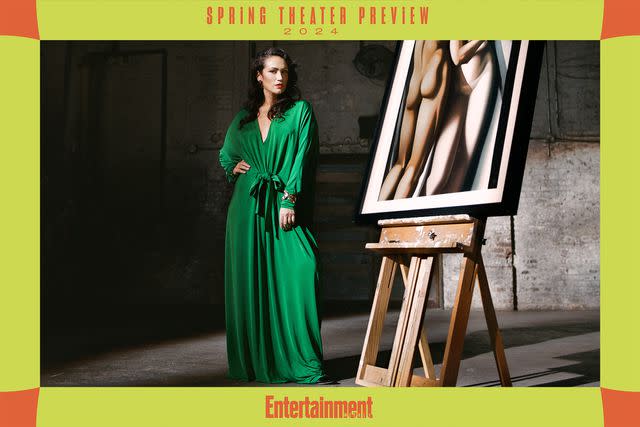
Emilio Madrid
Eden Espinosa is Tamara Lempicka in 'Lempicka'
"I did not want to bring any of her sensibilities into the design," says Hernandez, while Young adds, “[The show] feels like a music video. It’s Metropolis meets Madonna.”
For the scenic design, which Hernandez describes as more of an installation than a set, he turned to varied sources, including architecture of the 1920s and '30s, and even Bolshevik and Fascist propaganda. His set is an evocative base that can be transformed with the added design elements of lighting and costuming.
“I merged things like Soviet Constructivism — like the work of the [artist] Popova, [actor and director] Meyerhold mixed with [painter and photographer] Moholy-Nagi and [sculptor] Naum Gabo,” says Hernandez. “They were doing all these angular pieces, all very sculptural. And then of course, paying attention to the world of [co-author of The Fascist Manifesto] Marinetti, [painter] Boccioni, all Futurists."
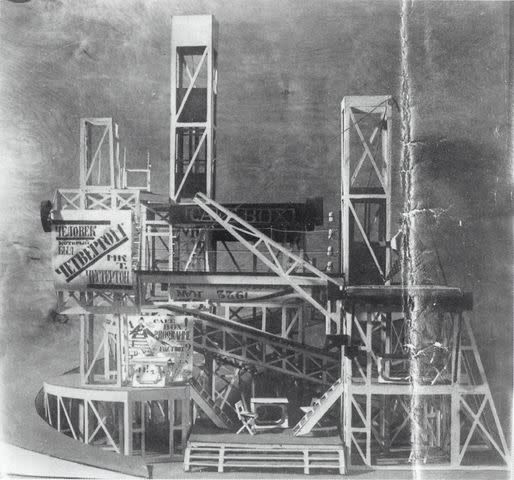
courtesy of 'Lempicka' producers
Aleksandr Vesnin Model that inspired 'Lempicka' set design"At the same time, I was looking at the politics of the day," he continues. "How do we merge Soviet graphic art with fascism?. It was a question of creating this installation that somehow had all these elements and knowing that with clothing, with projections, with lighting, we can bring different sensibilities to her Paris studio or the world of Parisian, bohemian life or the Monocle Cafe, but all of it is in this installation space.”
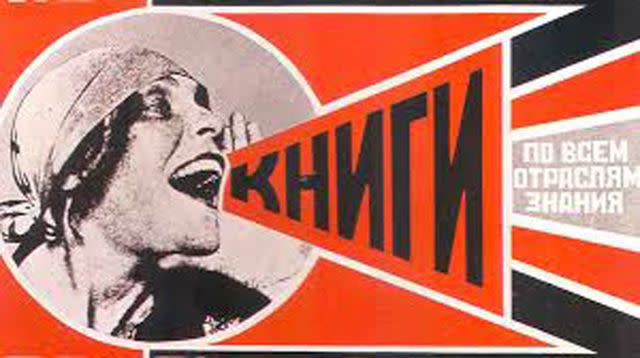
courtesy of 'Lempicka' producers
Soviet propagandaThe throughline of these movements and the era in which Lempicka lived is a sense of kinetic energy and movement, particularly one dominated by machines — and that aesthetic was what both Hernandez and Young aimed to bring to their designs.”Tamara is building who she is as an artist and as a person with this constant undertone of martial threat,” says Young. “There's always a menace that's like a river running underneath her, but that menace is very mechanical, like the machines of war. And sometimes those machines are people.”
Adds Hernandez: “The thing that I also needed to capture was a space that allowed for that energy, motion, and dynamics of space in order for things to be fluid within the structure.” Hernandez also explains that the references to constructivism and machines are grounded in the Soviet emphasis on the worker, which is why he also turned to the crisp lines and imagery of propaganda.
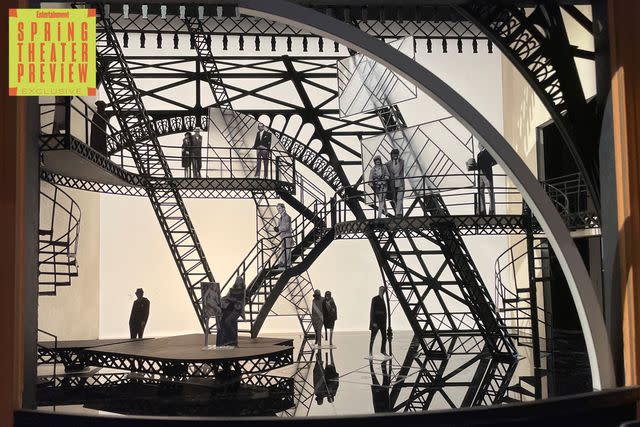
Riccardo Hernandez
The set of 'Lempicka' on Broadway
"The way Soviet theater makers were dealing with a machine and motion, it was creating the new man of the future, which is the worker,” he notes. “I felt that there was a very distinct connection with what Marinetti and the Futurists were doing. If you look at those posters, there's an incredible sense of movement. It is very, very kinetic. The work of Lempicka fits into that environment; these people are trying to break through the canvas. It is that sense of kinetic movement, passion and spectacle."
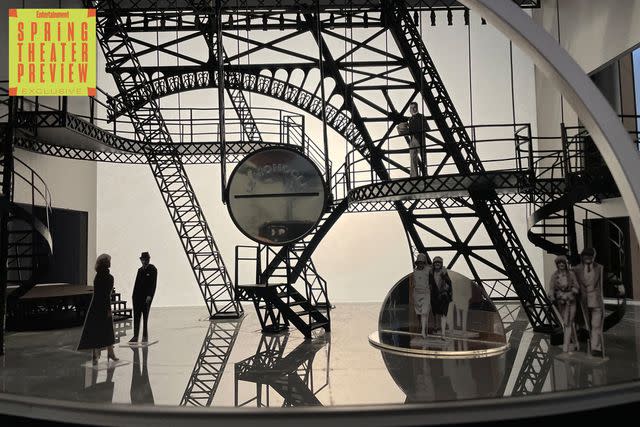
Riccardo Hernandez
The set of 'Lempicka' on BroadwayHernandez’s other major inspiration in his design was the Eiffel Tower, a structure that juxtaposes the harsh lines of its steel edifice with more romantic curves. “The lines that I have in the space are pretty geometric,” says Hernandez. “But the one thing that I was able to do is to blend the softness of the Eiffel Tower with the diagonals that are much more visceral without romanticizing the piece.”
While Hernandez was predominantly inspired by the social and political movements surrounding Tamara Lempicka’s story, Young turned more to the artist's paintings — but not in the way you might expect. Young isn’t interested in creating exact replicas of outfits in Lempicka’s work or of copying photographs of Tamara's clothing and hairstyles. Instead, her process is more intangible.
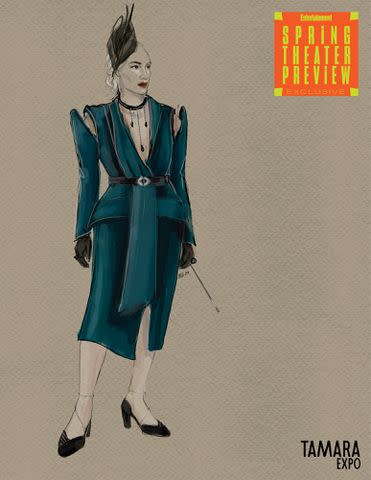
Illustrations by Bee Gable, David Hyman and Paloma Young
Lempicka costume sketches“The pressure is to capture the way people feel when they look at her paintings,” she says. “I want them to walk out of the show and feel like they got that experience, in addition to the insight into who she was as a person and her history. Those paintings are sexy and seductive. What I was trying to do with the design is to give the audience something seductive and powerful.”
That idea came from Madonna, who has used Lempicka’s work in multiple music videos and concert tours, including her ongoing Celebration Tour. “It was a way to look at how someone else had taken Tamara's work and reimagined it and let it influence a totally different shape,” Young explains. “I revisited a lot of Madonna stuff from the ‘90s. Nothing is a copy of that, but it was a way to see the influence. What was most inspiring was like, we can go in a different direction, we can take that big step.”
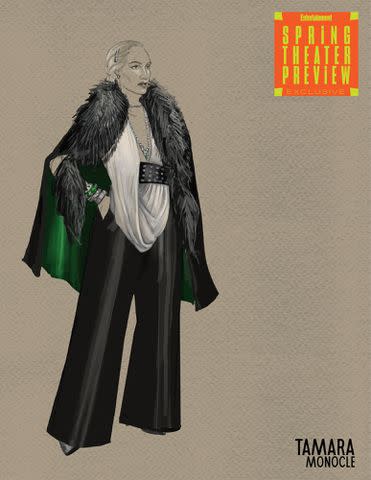
Illustrations by Bee Gable, David Hyman and Paloma Young
'Lempicka' costume sketchesSo don’t expect to turn up to Lempicka and see a stage full of replicas of 1930s and '40s clothing. "This is a memory story,” Young says. “We're taking the essence of who Tamara sees herself as. She was iconic and ahead of her time. She was unconventional, and she was style-defining as opposed to being a paragon of the style that already existed.”
The main reference points in Lempicka’s paintings for Young were her intense use of color and the preponderance of naked bodies. ”She has these really bold colors,” says Young. “The way that she paints fabric, it's satins and metallics and cashmeres — things that when they make a shadow, that shadow goes to black, and then it comes out a really bold color on the other side. We wanted it to have those colors and that feeling of a flowing structure because in her paintings, everything feels rigid and flowing at the same time.”
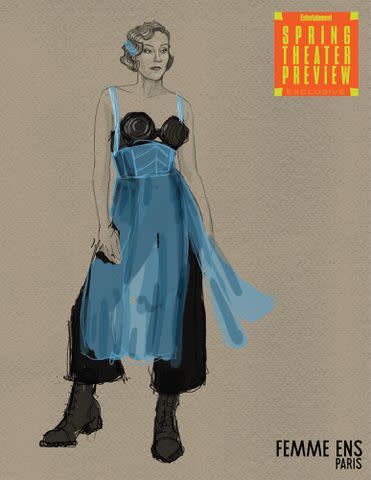
Illustrations by Bee Gable, David Hyman and Paloma Young
'Lempicka' costume sketchesAs for Lempicka’s frequent use of nudity in her work, Young didn’t want to approach that aspect of the work in strictly a literal sense. “We want a lot of body in the show,” she says. “But when you talk about nudity on stage, full nudity can be really limiting in a way that it can be distancing for an audience. It evokes a lot of feelings that are not the feeling of looking at a painting, especially one of her paintings of the body. So, there's a lot of using fabric on the drape of things to help us see the breathing body under the costume without being just a skin show.”
It's all defying convention when it comes to plotting a biographical musical (including the ways these design choices are underpinned Matt Gould’s heavily pop infused score). But defying convention was what Lempicka was all about — and that’s the point for both Hernandez and Young.
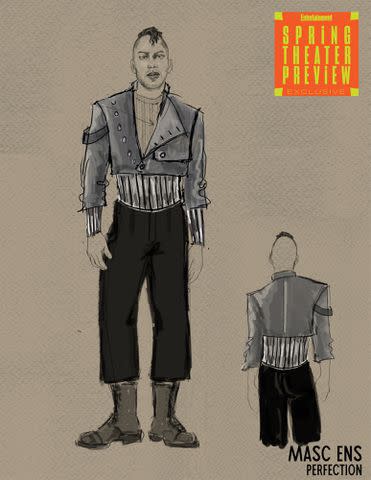
Illustrations by Bee Gable, David Hyman and Paloma Young
'Lempicka' costume sketches“We took some big leaps because we want to give people the energy of her work,” reflects Young. “You can't achieve that by having something that is at human scale. Because the way that she paints, even though the paintings are small, they feel enormous. So even though by default the [show] is human scale, the design should feel larger than life.”
Lempicka, starring Eden Espinosa as the titular painter, begins performances on March 19 ahead of an April 14 opening at the Longacre Theatre.
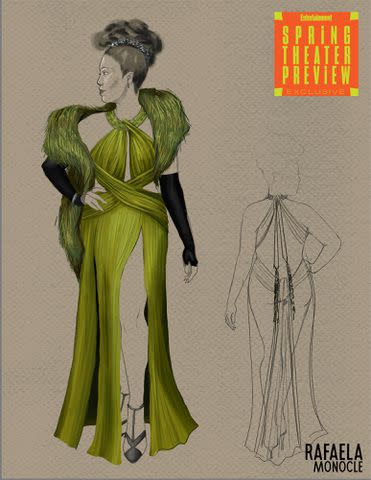
Illustrations by Bee Gable, David Hyman and Paloma Young
'Lempicka' costume sketchesRelated content:
How a box of The Notebook tissues became Broadway's hottest merch
Watch Jeremy Jordan and Eva Noblezada sing 'For Her/My Green Light' from The Great Gatsby musical
Doubt: A Parable review: Amy Ryan and Liev Schreiber are electric on Broadway
Read the original article on Entertainment Weekly.

